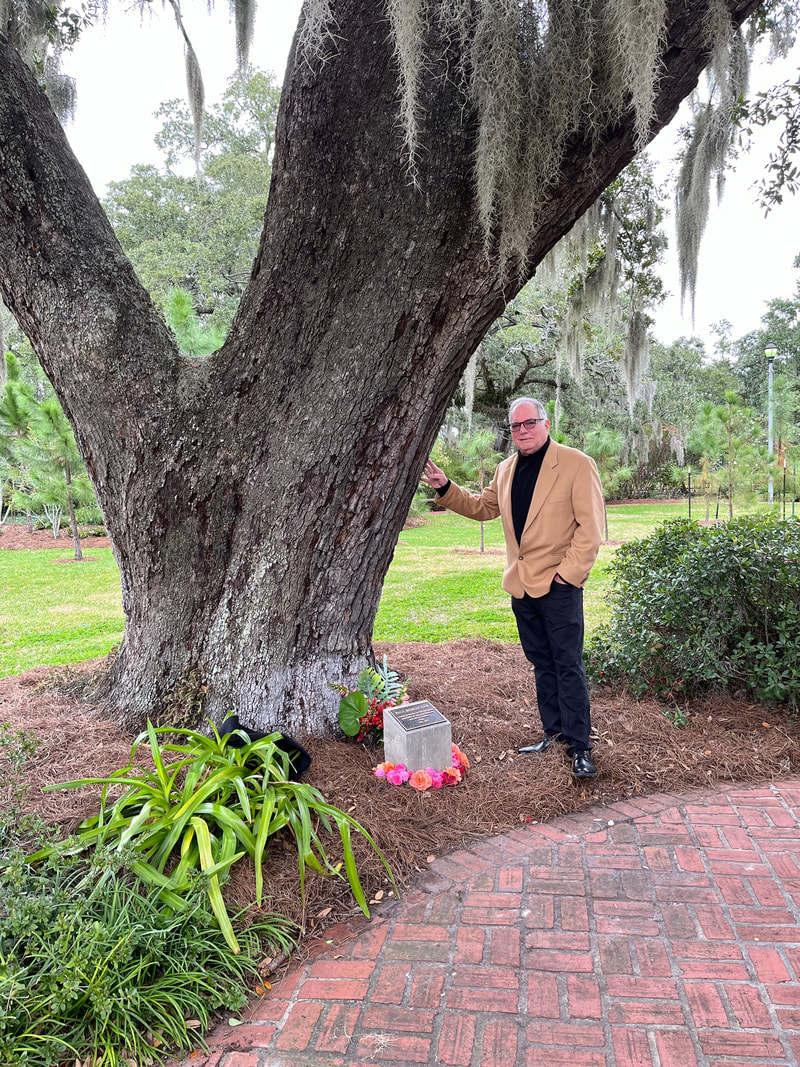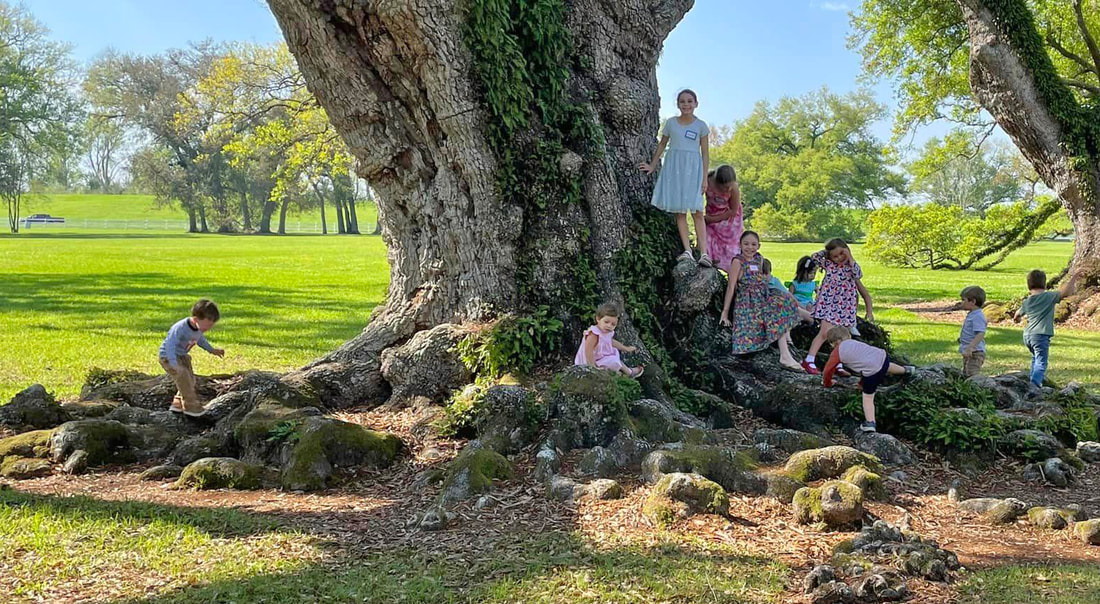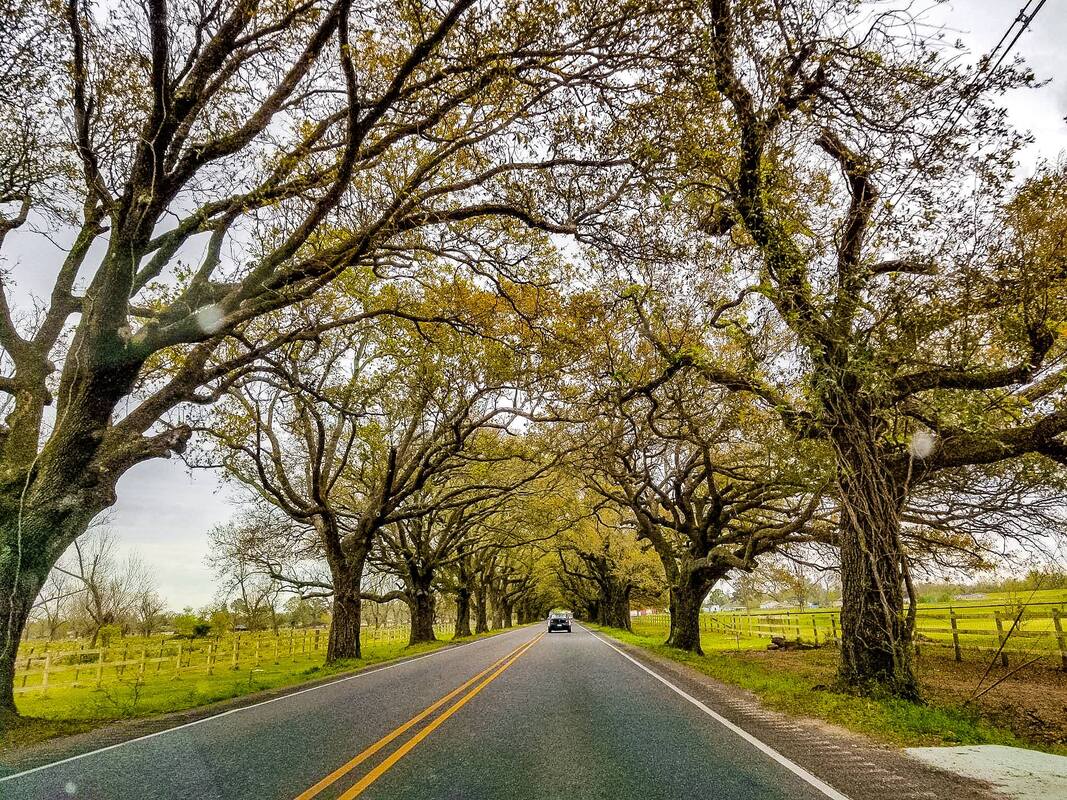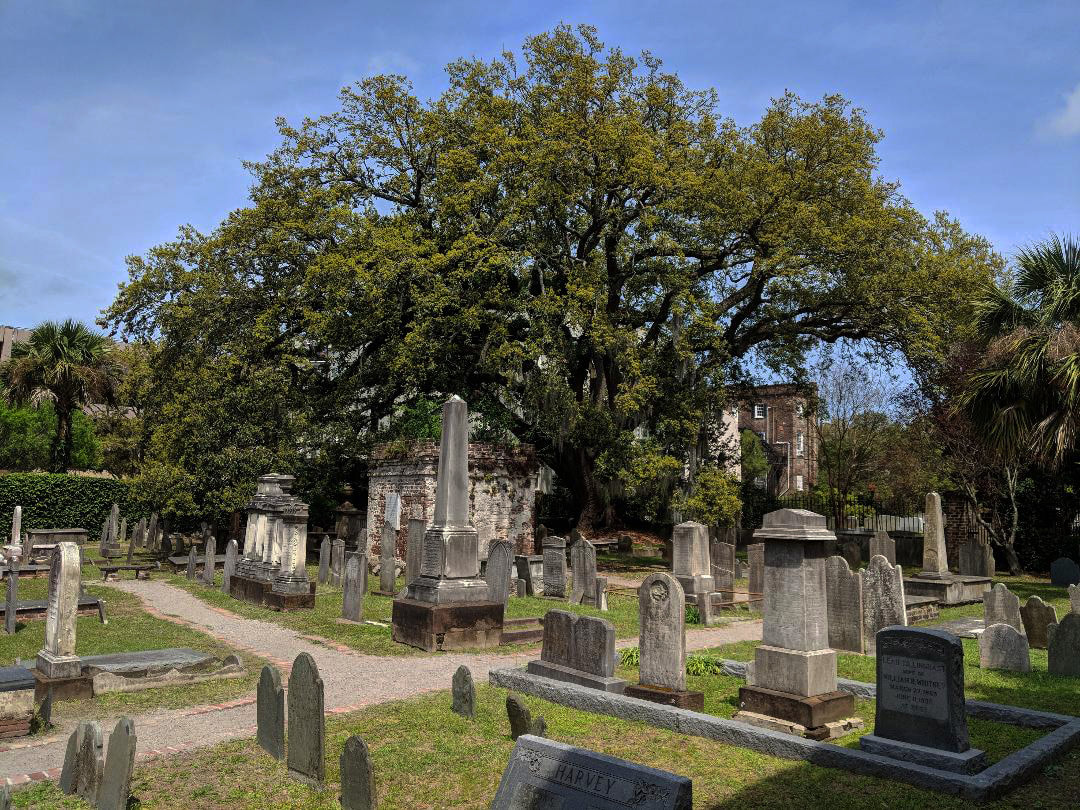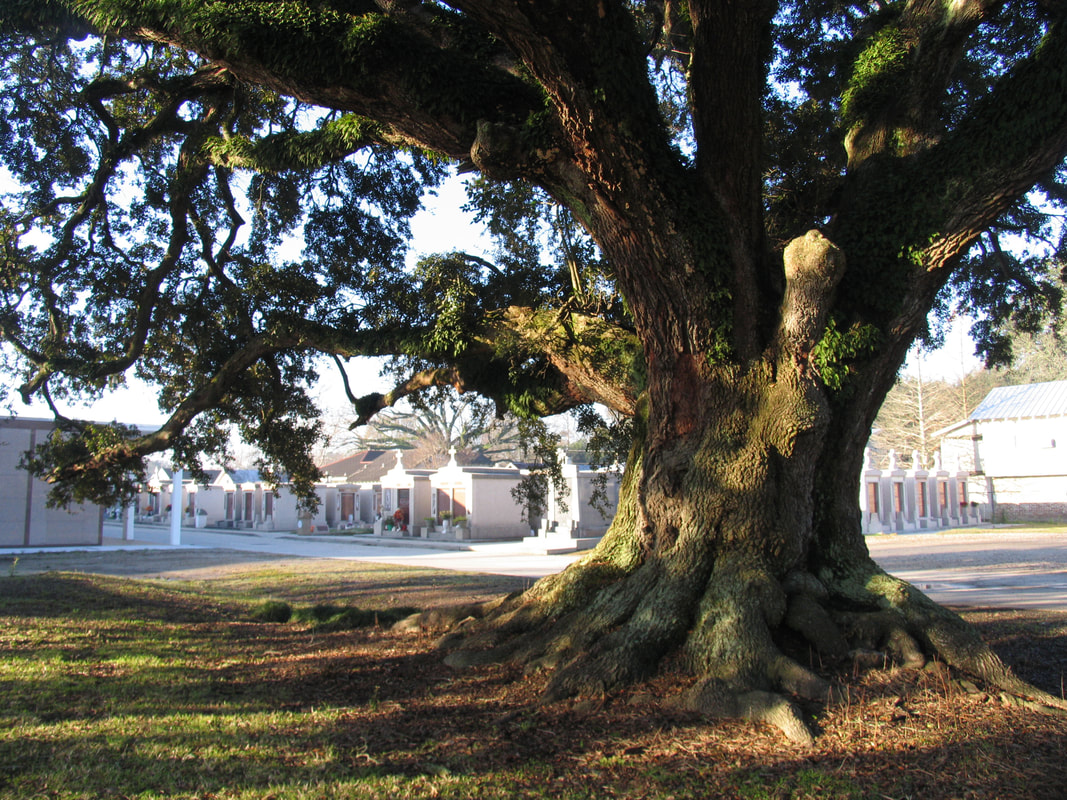Dedication of the Paul Soniat Oak Tree, City Park
November 30, 2023
Paul Soniat is congratulated at the Oak by LGCF President Patricia Ortlano, Coleen Perilloux Landry and Mary Ellen Miller
Mr. Paul Soniat, director of the New Orleans Botanical Garden in City Park for the past 41 years, retired on November 30, 2023. The Live Oak Society Chairman Coleen Perilloux Landry honored him by sponsoring an oak in his name. A ceremony was held near the tree in the Botanical Garden with 40 invited guests who had helped with the Garden through the years, whether helping to build the Pavilion of the Two Sisters, sponsoring the "Thursday at Twilight" concert series, helping with Celebration in the Oaks and many other facets that helped the Garden and gave pleasure to millions through the years. A luncheon was held at the Tavern in the Park restaurant following the ceremony.
"The Paul Soniat Oak" is # 10,012 on the Live Oak Society registry.
"The Paul Soniat Oak" is # 10,012 on the Live Oak Society registry.
Coleen Perilloux Landry - New Orleans Magazine
October 31, 2008
“Suburbia is where the developer bulldozes out the trees, then names the streets after them.”
–Bill Vaughan, American newspaper columnist and author
Rule No. 1: Never confuse Coleen Perilloux Landry with the common genus, Tree Huggersaurus Americanus.
There are live oak trees, some mere toddlers, between 500 and 600 years old, that (Landry would say “who”) are alive and thriving today, because Coleen Landry faced down bulldozers, politicians and big bucks to keep them growing and spreading.
But don’t take my word for it! Just ask any of the 5,874 members of the Live Oak Society. Oh, that’s right, they can’t talk. All the members, including the board of directors, are trees. But to paraphrase the poet: “They also serve who only stand and … spread their branches!”
“I’ve had a love of trees ever since I was a little girl,” says the tall, blonde chairman (“Not chairperson or chairlady…but chairman, please!”) who grew up in Montz, in St. Charles Parish. “My mother would never let anybody cut one twig off any of her oak trees. Never! One day my father put a swing on one of our oaks and I would swing way up into branches, way up into the leaves, and I’d feel so safe and free there. It was a memory I will always cherish.”
If Landry feels like a one-woman army protecting the giant Southern Live Oak (Quercus virginiana) that grows in only 14 Southern states (most prolific in Louisiana) it’s because she is: The Live Oak Society is Coleen Perilloux Landry.
“The Live Oak Society has always been that way since its founding in 1934,” Landry says. “I’m the only human in the society. The members are the trees. The officers are the trees and where and when they hold their meetings…well, they never tell me. The president is the ‘Seven Sisters Oak’ who lives in Mandeville. But I do meet with the trees, quite often. That’s one of the things my son tells me, ‘Mom, you’ve got an organization where the members can’t talk back to you.’”
To be sure, Landry has been the one doing most of the talking since she moved into the chairman’s job in 2001.
And, it hasn’t been all talk and no action. While it wasn’t exactly the reenactment of a lone protester facing down tanks in Tienanmen Square, Landry has stood toe-to-toe with bulldozers in Lakeview and once talked former Governor Mike Foster into giving a reprieve to a condemned monster live oak that has gone on to folklore status as “Old Dickory” in Harahan. To boot, she’s traveled the length and breadth of the 14-state growing region of the oaks with tape measure in hand to see “how fat” a tree is and how wide it is at its widest points. An 8-foot waistline qualifies an oak for membership into the Live Oak Society and its very own name.
“Not long ago there was this great oak in Lakeview, right along Bayou St. John. It was maybe 400 years old and it was on the path of an old Indian trading route. Indians actually stopped to rest under that oak and others there. Well, this man out there got tired of raking leaves so he called in a company to get rid of that tree. I talked three contractors out of cutting that tree down. Every time one would show up, I’d stand there and talk them out of it. The fourth one finally accepted the job and cut it down. We just can’t let things like that happen. People have got to be convinced that we need these magnificent oaks.”
Likewise, it took some convincing to get the late Jefferson Parish sheriff Harry Lee to come around to Landry’s way of thinking. But in the end, she – and Old Dickory – had Lee spouting Joyce Kilmer poetry: “I think I shall never see/A poem as lovely as a tree …”
It all started with plans for a subdivision and a federally funded drainage project in Harahan near Dickory Avenue and Jefferson Highway. Sitting smack dab in the way was the sprawling and majestic 600 year old oak, Old Dickory.
“I went to Sheriff Lee and he told me I was fighting a battle I couldn’t win,” Landry says. “I couldn’t stop there. I took a picture of Old Dickory and put that picture on Gov. Foster’s desk. Well, Gov. Foster is a big oak lover. In fact, he has many on his place (ironically named, “Oaklawn Manor”) in St. Mary Parish. The governor immediately got on the phone and called the highway department and who knows who else. Plans were redrawn and Old Dickory wasn’t touched. When he realized what I had done, Sheriff Lee called and apologized and decided to throw a big party to dedicate Old Hickory.”
It was a dedication replete with Lee spouting the lines from Kilmer, and Father Randy Roux sprinkling Old Dickory with holy water and invoking the heavens: “Let us pray that we can continue to preserve God’s creation, because we are the stewards.” As people walked around Old Hickory’s 25-foot girth that afternoon, nobody stood taller than Coleen Perilloux Landry.
“If only people realized what we have in these oaks,” she says. “They actually save lives. If you have one in your yard, it’s like a canopy. It actually protects you during a storm. A large oak will buffer the winds in a hurricane and push the winds up and over your house. Branches may break off, but those massive trunks will stand firm. They do so much for us and still, people want to cut them down.
“During Katrina there were people in Bay St. Louis who ran a bed and breakfast. Their building had withstood Camille (Hurricane Camille which slammed into the Mississippi Gulf Coast in 1969) so they figured it could withstand Katrina. They decided to stay and ride it out. When the tidal surges came, their house began to break apart. The people were able to float a few yards to this magnificent oak tree they had and three of the people managed to climb into the oak with their dog. One of the men said, ‘I hung on for three-and-a-half hours and I kept kissing and hugging that branch.’ They all survived, but when the cleanup began after the hurricane, the bulldozers came in and took that tree down. Nobody gave any thought to saving it.”
Landry pulls out post-Katrina photos showing the durability of the oaks at West End. Land where once stood the landmark restaurants, Bruning’s, Fitzgerald’s, Maggie’s Crab Net and others, now sits flattened except for a strong stand of oak trees all around the area; St. Joseph Abbey in Covington, with it’s mighty oak, the “Abbot Paul Schauble Oak,” a quiet and inviting place of meditation, and even the gargantuan, “Martha Washington Oak,” growing and thriving despite its roots being trampled daily in the middle of the rhinoceros exhibit at Audubon Zoo.
“Martha Washington is a vice president of the Live Oak Society,” Landry says, then adds with a wink, “You’d think the rhinos would show a little more respect. I know it’s real hard work to get people to do that. We seem to just take our live oaks for granted. They give so much and never ask anything of us. But in fact, more people are finally starting to think before they act. More and more contractors and developers are starting to call and inquire about a particular oak before they just bulldoze it down. What we really need though is legislation to protect our oaks. Except for a tiny little strip in old Jefferson, our oaks don’t have that protection. These oaks are our heritage and our legacy … they’re our South.”
And so, Coleen Perilloux Landry, tape measure in hand, will continue to record the girths of the monolithic oaks for future registration, talk up the benefits of Quercus virginiana and make her presence felt in the halls of the state capital, all the while paraphrasing Kilmer, as Ogden Nash did:
“I think that I shall never see
A billboard lovely as a tree
Perhaps, unless the billboards fall,
I’ll never see a tree at all.”
–Bill Vaughan, American newspaper columnist and author
Rule No. 1: Never confuse Coleen Perilloux Landry with the common genus, Tree Huggersaurus Americanus.
There are live oak trees, some mere toddlers, between 500 and 600 years old, that (Landry would say “who”) are alive and thriving today, because Coleen Landry faced down bulldozers, politicians and big bucks to keep them growing and spreading.
But don’t take my word for it! Just ask any of the 5,874 members of the Live Oak Society. Oh, that’s right, they can’t talk. All the members, including the board of directors, are trees. But to paraphrase the poet: “They also serve who only stand and … spread their branches!”
“I’ve had a love of trees ever since I was a little girl,” says the tall, blonde chairman (“Not chairperson or chairlady…but chairman, please!”) who grew up in Montz, in St. Charles Parish. “My mother would never let anybody cut one twig off any of her oak trees. Never! One day my father put a swing on one of our oaks and I would swing way up into branches, way up into the leaves, and I’d feel so safe and free there. It was a memory I will always cherish.”
If Landry feels like a one-woman army protecting the giant Southern Live Oak (Quercus virginiana) that grows in only 14 Southern states (most prolific in Louisiana) it’s because she is: The Live Oak Society is Coleen Perilloux Landry.
“The Live Oak Society has always been that way since its founding in 1934,” Landry says. “I’m the only human in the society. The members are the trees. The officers are the trees and where and when they hold their meetings…well, they never tell me. The president is the ‘Seven Sisters Oak’ who lives in Mandeville. But I do meet with the trees, quite often. That’s one of the things my son tells me, ‘Mom, you’ve got an organization where the members can’t talk back to you.’”
To be sure, Landry has been the one doing most of the talking since she moved into the chairman’s job in 2001.
And, it hasn’t been all talk and no action. While it wasn’t exactly the reenactment of a lone protester facing down tanks in Tienanmen Square, Landry has stood toe-to-toe with bulldozers in Lakeview and once talked former Governor Mike Foster into giving a reprieve to a condemned monster live oak that has gone on to folklore status as “Old Dickory” in Harahan. To boot, she’s traveled the length and breadth of the 14-state growing region of the oaks with tape measure in hand to see “how fat” a tree is and how wide it is at its widest points. An 8-foot waistline qualifies an oak for membership into the Live Oak Society and its very own name.
“Not long ago there was this great oak in Lakeview, right along Bayou St. John. It was maybe 400 years old and it was on the path of an old Indian trading route. Indians actually stopped to rest under that oak and others there. Well, this man out there got tired of raking leaves so he called in a company to get rid of that tree. I talked three contractors out of cutting that tree down. Every time one would show up, I’d stand there and talk them out of it. The fourth one finally accepted the job and cut it down. We just can’t let things like that happen. People have got to be convinced that we need these magnificent oaks.”
Likewise, it took some convincing to get the late Jefferson Parish sheriff Harry Lee to come around to Landry’s way of thinking. But in the end, she – and Old Dickory – had Lee spouting Joyce Kilmer poetry: “I think I shall never see/A poem as lovely as a tree …”
It all started with plans for a subdivision and a federally funded drainage project in Harahan near Dickory Avenue and Jefferson Highway. Sitting smack dab in the way was the sprawling and majestic 600 year old oak, Old Dickory.
“I went to Sheriff Lee and he told me I was fighting a battle I couldn’t win,” Landry says. “I couldn’t stop there. I took a picture of Old Dickory and put that picture on Gov. Foster’s desk. Well, Gov. Foster is a big oak lover. In fact, he has many on his place (ironically named, “Oaklawn Manor”) in St. Mary Parish. The governor immediately got on the phone and called the highway department and who knows who else. Plans were redrawn and Old Dickory wasn’t touched. When he realized what I had done, Sheriff Lee called and apologized and decided to throw a big party to dedicate Old Hickory.”
It was a dedication replete with Lee spouting the lines from Kilmer, and Father Randy Roux sprinkling Old Dickory with holy water and invoking the heavens: “Let us pray that we can continue to preserve God’s creation, because we are the stewards.” As people walked around Old Hickory’s 25-foot girth that afternoon, nobody stood taller than Coleen Perilloux Landry.
“If only people realized what we have in these oaks,” she says. “They actually save lives. If you have one in your yard, it’s like a canopy. It actually protects you during a storm. A large oak will buffer the winds in a hurricane and push the winds up and over your house. Branches may break off, but those massive trunks will stand firm. They do so much for us and still, people want to cut them down.
“During Katrina there were people in Bay St. Louis who ran a bed and breakfast. Their building had withstood Camille (Hurricane Camille which slammed into the Mississippi Gulf Coast in 1969) so they figured it could withstand Katrina. They decided to stay and ride it out. When the tidal surges came, their house began to break apart. The people were able to float a few yards to this magnificent oak tree they had and three of the people managed to climb into the oak with their dog. One of the men said, ‘I hung on for three-and-a-half hours and I kept kissing and hugging that branch.’ They all survived, but when the cleanup began after the hurricane, the bulldozers came in and took that tree down. Nobody gave any thought to saving it.”
Landry pulls out post-Katrina photos showing the durability of the oaks at West End. Land where once stood the landmark restaurants, Bruning’s, Fitzgerald’s, Maggie’s Crab Net and others, now sits flattened except for a strong stand of oak trees all around the area; St. Joseph Abbey in Covington, with it’s mighty oak, the “Abbot Paul Schauble Oak,” a quiet and inviting place of meditation, and even the gargantuan, “Martha Washington Oak,” growing and thriving despite its roots being trampled daily in the middle of the rhinoceros exhibit at Audubon Zoo.
“Martha Washington is a vice president of the Live Oak Society,” Landry says, then adds with a wink, “You’d think the rhinos would show a little more respect. I know it’s real hard work to get people to do that. We seem to just take our live oaks for granted. They give so much and never ask anything of us. But in fact, more people are finally starting to think before they act. More and more contractors and developers are starting to call and inquire about a particular oak before they just bulldoze it down. What we really need though is legislation to protect our oaks. Except for a tiny little strip in old Jefferson, our oaks don’t have that protection. These oaks are our heritage and our legacy … they’re our South.”
And so, Coleen Perilloux Landry, tape measure in hand, will continue to record the girths of the monolithic oaks for future registration, talk up the benefits of Quercus virginiana and make her presence felt in the halls of the state capital, all the while paraphrasing Kilmer, as Ogden Nash did:
“I think that I shall never see
A billboard lovely as a tree
Perhaps, unless the billboards fall,
I’ll never see a tree at all.”
#9385 "THE GIARRUSSO FAMILY OAK"
Live Oak Society chairman Coleen Perilloux Landry presents the Certificate of Registration of #9385 "THE GIARRUSSO FAMILY OAK" to Councilman Joe Giarrusso of New Orleans. The presentation was made at a Civic Association meeting in Lakeview, New Orleans. Councilman Joe Giarrusso is currently providing education and protection of the Live Oaks throughout Lakeview.
"Old Dickory"
Live Oak Society Photos
Descendants of Eugene LeBlanc of Sunshine, Louisiana, on one of the ancient Live Oaks at Oak Alley in Vacherie, LA.
#9387 UNCLE EARL - Richard and Helene Tucker
#10,013-#10,015 Christina M. Baudot and Chase Anthony Baudot - Folsom, LA - St. Tammany Parish
Ashley Wilkes #9396 and Scarlett O'Hara #9397 Live Oaks in Prairieville LA
St. Bernard Highway in Chalmette--- a tunnel of live oaks putting on their new leaves. (photo by Louis Phillips, Jr.-2020)
Allee' of Live Oaks at the Convent of the Sacred Heart Nuns in Grand Coteau, Louisiana
Click images to enlarge
Oak Alley
LOS registry # 7494 "The Jane Amundson Lafargue Oak"
|
"The Jane Amundson Lafargue Oak", a memorial oak, measures 23 feet 5 inches in girth. It has survived many hurricanes but also received a lot of damage from Hurricanes. It is on Rienzi Plantation in Thibodaux, LA and was registered by her son, Mr. John Lafargue as an honor to his deceased mother.
Dedicated on October 12, 2014 with over 100 people in attendance. The Culinary School at Nicholls State was hired to do the food. Mr. Lafargue had given his mother's eggnog recipe to one of the women chefs and she made divinity fudge with the recipe. Live Oak Society Chairman, Coleen Perilloux Landry, christened the tree with water from Bayou Lafourche with a branch of Rosemary for Remembrance. |
|
|
Mr. Norman Lafargue of Shreveport, also a son of Jane's, read the poem "I think that I shall never see.....a poem as lovely as a tree...." Mrs. Louise Munson Dupont who grew up on Albania Plantation in Franklin, Louisiana was a long time friend of Mrs. Jane Amundson Lafargue and one of the few surviving members of "the bridge club" read the blessing along with John. Notice her cane is decorated for the occasion to match her scarf. |
Cecelia Toups Oak in Raceland



